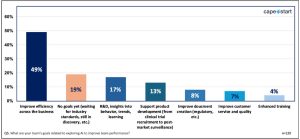Unlocking Performance: How AI Goals Are Shaping Team Productivity
Organizations are recognizing the promise of Artificial Intelligence (AI). It’s becoming an essential tool for improving team performance. In CapeStart’s Life Science AI Research Report, respondents shared their internal organizational goals for exploring AI, offering a glimpse into how life science organizations are leveraging the technology to optimize efficiency and drive innovation.
Top AI Goals for Improving Team Performance
The report highlights several common goals that life science organizations aim to achieve with AI:
- Improving Workflow Efficiency—A priority for many teams is streamlining workflows, with nearly half of the respondents reporting workflow efficiency as a focus. By automating repetitive tasks and optimizing resource allocation, AI allows teams to focus on higher-value activities. Tools like intelligent automation and real-time data processing are key to achieving this goal.
- Advancing R&D Initiatives—Teams are exploring AI-powered solutions to analyze complex datasets, predict trends, and streamline experimentation processes. By integrating AI into R&D workflows, organizations can significantly shorten innovation timelines and improve the accuracy of research outcomes.
- Enhancing Clinical Research— Many life science teams are adopting AI to enhance clinical research efforts. By analyzing datasets, identifying trends, and predicting outcomes, AI can reduce research timelines, thereby accelerating certain aspects of clinical research.
- Document Generation and Summarization—The ability to generate and summarize complex documents is another significant focus area. Teams are exploring AI to handle large volumes of data, synthesize insights, and quickly produce actionable reports. This goal is particularly relevant for industries like healthcare and life sciences, where documentation is both critical and time-intensive.

Interestingly, nearly one in five respondents reports that no goals are set yet, with companies either waiting for industry standards to emerge or remaining in the discovery phase for various reasons.
Why These Goals Matter
The emphasis on these goals reflects a broader understanding of AI’s potential to enhance productivity, accuracy, and creativity. By addressing pain points like manual workloads and data bottlenecks, AI empowers teams to perform at their best.
Challenges to Achieving These Goals
Despite their ambitions, teams face barriers that could slow progress with many respondents reporting knowledge and resource limitations, as well as cost and budget constraints, hindering their ability to advance AI strategies.
How to Overcome These Challenges
Organizations can take steps to achieve their AI goals effectively:
- Invest in Training: Upskilling team members ensures they can leverage AI tools confidently.
- Partner with Vendors: Working with experienced vendors provides access to expertise and advanced technologies.
- Start Small: Focusing on specific, high-impact use cases helps build momentum for broader AI adoption.
The Future of Team Performance with AI
CapeStart’s Life Science AI Research Report highlights the immense potential AI holds for transforming team performance. By focusing on clear, actionable goals and addressing implementation challenges, organizations can harness AI to unlock new levels of efficiency, innovation, and success.
Explore the full insights from CapeStart’s Life Science AI Research Report to see how businesses are shaping their AI strategies to improve performance and stay competitive in today’s rapidly evolving landscape.


